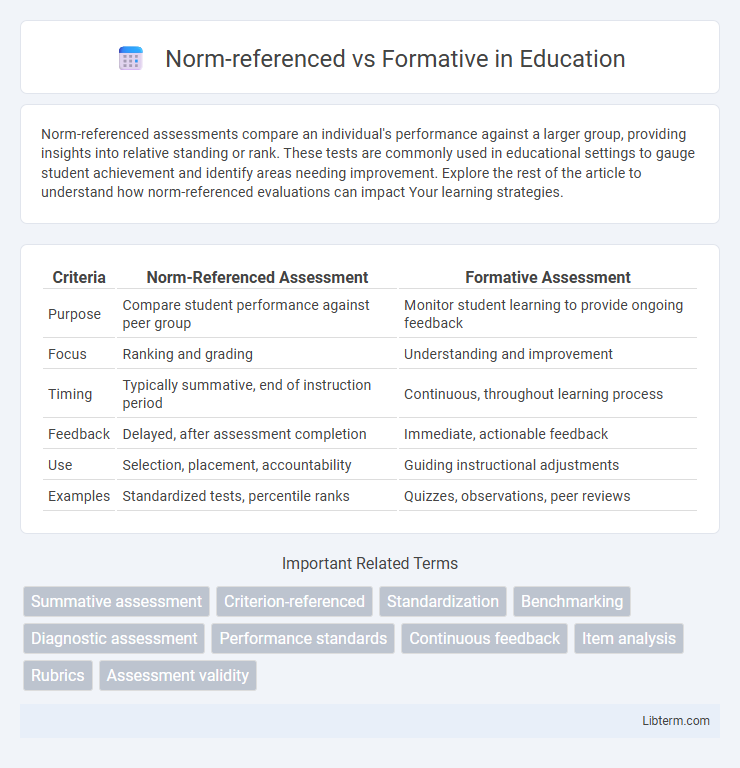Norm-referenced assessments compare an individual's performance against a larger group, providing insights into relative standing or rank. These tests are commonly used in educational settings to gauge student achievement and identify areas needing improvement. Explore the rest of the article to understand how norm-referenced evaluations can impact Your learning strategies.
Table of Comparison
| Criteria | Norm-Referenced Assessment | Formative Assessment |
|---|---|---|
| Purpose | Compare student performance against peer group | Monitor student learning to provide ongoing feedback |
| Focus | Ranking and grading | Understanding and improvement |
| Timing | Typically summative, end of instruction period | Continuous, throughout learning process |
| Feedback | Delayed, after assessment completion | Immediate, actionable feedback |
| Use | Selection, placement, accountability | Guiding instructional adjustments |
| Examples | Standardized tests, percentile ranks | Quizzes, observations, peer reviews |
Introduction to Norm-Referenced and Formative Assessment
Norm-referenced assessments compare a student's performance against a group, ranking individuals to identify relative standing within a cohort. Formative assessments provide ongoing feedback during the learning process, enabling educators to adjust instruction and support student growth effectively. Both types serve distinct purposes: norm-referenced assessments focus on benchmarking, while formative assessments emphasize continuous improvement and personalized learning.
Defining Norm-Referenced Assessment
Norm-referenced assessment measures a student's performance by comparing it to a predefined group, often resulting in percentile ranks or standard scores that indicate relative standing. This type of evaluation emphasizes ranking students within a cohort, making it ideal for selection or placement decisions. Unlike formative assessments aimed at guiding instructional improvements, norm-referenced tests provide benchmarks for evaluating overall achievement.
Understanding Formative Assessment
Formative assessment focuses on ongoing feedback to enhance student learning and guide instructional adjustments. It emphasizes identifying individual learning needs rather than comparing students against a norm-referenced group. Effective formative assessment strategies include quizzes, observational checks, and peer reviews that provide real-time insights into student progress.
Key Differences between Norm-Referenced and Formative Assessment
Norm-referenced assessment compares a student's performance against a larger group, ranking individuals to identify relative standing, while formative assessment focuses on ongoing feedback to improve learning and guide instruction. Norm-referenced tests emphasize standardized scoring and percentile ranks, whereas formative assessments prioritize qualitative feedback, development, and mastery of specific skills. The key difference lies in the purpose: norm-referenced assesses ability compared to peers; formative supports continuous learning and instructional adjustment.
Purposes and Goals in Educational Settings
Norm-referenced assessments aim to rank students by comparing their performance to peers, identifying relative standing and percentile ranks within a group. Formative assessments focus on monitoring individual student learning progress to provide timely feedback that informs instruction and supports skill development. The primary goal of norm-referenced assessments is selection and placement, while formative assessments aim to enhance learning and improve educational outcomes.
Advantages of Norm-Referenced Assessment
Norm-referenced assessments provide the advantage of comparing individual student performance against a larger population, enabling educators to identify relative strengths and weaknesses accurately. These assessments offer standardized benchmarks that help in diagnosing learning gaps and tracking progress over time across diverse groups. Their reliability and objectivity make them essential tools for selection, placement decisions, and large-scale accountability measures.
Benefits of Formative Assessment
Formative assessment provides real-time insights into student learning, enabling educators to tailor instruction and address knowledge gaps promptly. It promotes active student engagement and self-regulation by offering continuous feedback that guides improvement before summative evaluations. This approach fosters a deeper understanding and skill development, contrasting with norm-referenced assessments that primarily rank performance against peers.
Challenges and Limitations of Each Approach
Norm-referenced assessments face challenges such as emphasizing rank over mastery, potentially overlooking individual learning needs and fostering competition rather than collaboration. Formative assessments may be limited by the time and resources required for ongoing feedback and adjustments, making consistent implementation difficult in large or diverse classrooms. Both approaches require careful balance to ensure effective student evaluation without unintended negative impacts on motivation or instructional quality.
Best Practices for Choosing Assessment Types
Selecting appropriate assessment types requires aligning with specific learning objectives and student needs; norm-referenced assessments excel in comparing student performance against a peer group, while formative assessments provide real-time feedback to guide instruction and improve learning outcomes. Best practices encourage using norm-referenced tests for summative evaluation and benchmarking, whereas formative assessments are ideal for monitoring progress and tailoring teaching strategies. Balancing both types ensures comprehensive insights into achievement levels and individual growth, enhancing educational effectiveness.
Conclusion: Selecting the Right Assessment Method
Choosing between norm-referenced and formative assessments depends on the objective: norm-referenced tests effectively measure student performance against a broader population, providing comparative data for grading or placement decisions. Formative assessments offer timely feedback, enabling personalized instruction and promoting continuous learning improvements. Selecting the appropriate method ensures alignment with educational goals, whether emphasizing relative achievement or fostering ongoing development.
Norm-referenced Infographic

 libterm.com
libterm.com